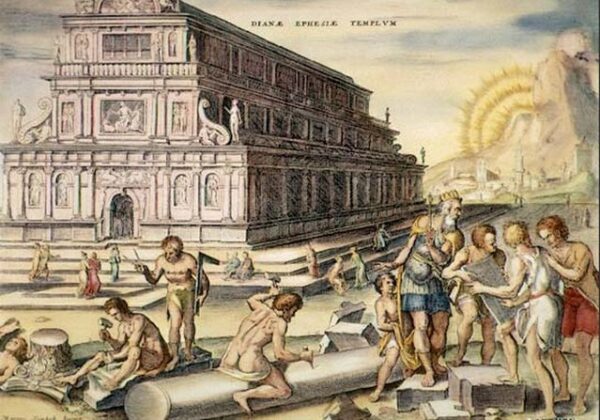On July 21, 356 BC, a madman set one of the ancient Wonders of the World ablaze. The Burning of the Temple of Artemis was a devastating event in Greece that has been lamented by historians over the millennia. This magnificent temple, dedicated to the goddess Artemis, was located in the city of Ephesus, near present-day Selcuk in Turkey. The temple was renowned for its grandeur.
On that infamous summer day, a peasant, or possibly a slave, named Herostratus entered the Temple of Artemis and set fire to its wooden beams. As the fire blazed, the marble columns holding the building up began to fall, leaving the once mighty temple in ruins.
“Upon capture and torture,” History Daily writes, “Herostratus admitted setting the fire, believing that such a horrendous act would cement his name in history’s memory. He was sentenced to death for the arson, but to ensure no one else would try to follow in his footsteps, Greek authorities implemented damnatio memoriae, or “condemnation of memory,” a law that prohibited speaking or writing the name of a condemned person. It was meant to erase Herostratus and any other criminal fame-seekers from history, but we’re still talking about him, so it can’t be called a rousing success.”
The local Ephesians were devastated, and the incident prompted widespread mourning and outrage.
The Temple of Artemis was constructed around 550 BCE and was designed by the architect Chersiphron. Its construction took several years and was completed by his son, Metagenes. The temple stood as a symbol of devotion to the Greek goddess Artemis, the goddess of the hunt, wild animals, and fertility. Its architectural splendor, with its marble columns, intricate sculptures, and ornate decorations, made it a remarkable sight to behold.
Despite the tragedy, the Ephesians became determined to rebuild the temple. Financing for the reconstruction came from various sources, including contributions from wealthy individuals and city-states throughout Greece. The rebuilding effort took several decades, and the new temple was even more magnificent than its predecessor. The reconstructed Temple of Artemis became a center of worship and a testament to the resilience and dedication of the ancient Greeks.
According to the Greek writer Plutarch in his biography of Alexander the Great, the great Macedonian empire builder was born on the very same day that the Temple of Artemis caught fire.
Remembering that Artemis was the goddess of childbirth, the ancient historian noted: “It was this coincidence which inspired Hegesias of Magnesia to utter a joke which was flat enough to have put the fire out: he said it was no wonder the temple of Artemis was destroyed, since the goddess was busy attending to the birth of Alexander. But those of the Magi who were then at Ephesus interpreted the destruction of the temple as the portent of a far greater disaster, and they ran through the city beating their faces and crying out that that day had brought forth a great scourge and calamity for Asia.”
Today, little remains of the Temple of Artemis. Over time, earthquakes, looting, and the reuse of materials in other construction projects have taken their toll on the once-majestic structure. However, the memory of this incredible temple lives on through historical accounts, ancient texts, and the admiration it continues to inspire. The burning of the Temple of Artemis stands as a tragic reminder of the impermanence of even the most awe-inspiring human creations and the enduring power of faith and determination.






